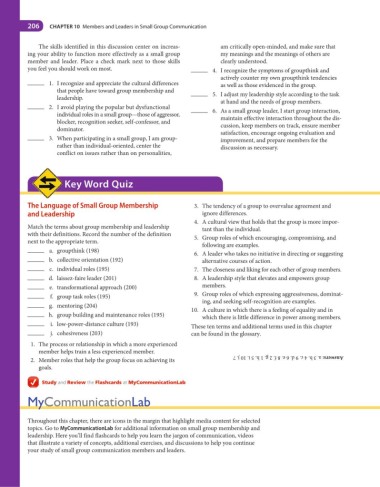Page 227 - Essentials of Human Communication
P. 227
206 Chapter 10 Members and Leaders in Small Group Communication
The skills identified in this discussion center on increas- am critically open-minded, and make sure that
ing your ability to function more effectively as a small group my meanings and the meanings of others are
member and leader. Place a check mark next to those skills clearly understood.
you feel you should work on most. 4. I recognize the symptoms of groupthink and
actively counter my own groupthink tendencies
1. I recognize and appreciate the cultural differences as well as those evidenced in the group.
that people have toward group membership and 5. I adjust my leadership style according to the task
leadership.
at hand and the needs of group members.
2. I avoid playing the popular but dysfunctional 6. As a small group leader, I start group interaction,
individual roles in a small group—those of aggressor, maintain effective interaction throughout the dis-
blocker, recognition seeker, self-confessor, and cussion, keep members on track, ensure member
dominator.
satisfaction, encourage ongoing evaluation and
3. When participating in a small group, I am group- improvement, and prepare members for the
rather than individual-oriented, center the discussion as necessary.
conflict on issues rather than on personalities,
Key Word Quiz
the language of small Group Membership 3. The tendency of a group to overvalue agreement and
and leadership ignore differences.
4. A cultural view that holds that the group is more impor-
Match the terms about group membership and leadership tant than the individual.
with their definitions. Record the number of the definition 5. Group roles of which encouraging, compromising, and
next to the appropriate term. following are examples.
a. groupthink (198) 6. A leader who takes no initiative in directing or suggesting
b. collective orientation (192) alternative courses of action.
c. individual roles (195) 7. The closeness and liking for each other of group members.
d. laissez-faire leader (201) 8. A leadership style that elevates and empowers group
e. transformational approach (200) members.
f. group task roles (195) 9. Group roles of which expressing aggressiveness, dominat-
ing, and seeking self-recognition are examples.
g. mentoring (204) 10. A culture in which there is a feeling of equality and in
h. group building and maintenance roles (195) which there is little difference in power among members.
i. low-power-distance culture (193) These ten terms and additional terms used in this chapter
j. cohesiveness (203) can be found in the glossary.
1. The process or relationship in which a more experienced
member helps train a less experienced member.
2. Member roles that help the group focus on achieving its Answers: a. 3 b. 4 c. 9 d. 6 e. 8 f. 2 g. 1 h. 5 i. 10 j. 7
goals.
Study and Review the Flashcards at MyCommunicationLab
MyCommunicationLab
Throughout this chapter, there are icons in the margin that highlight media content for selected
topics. Go to MyCommunicationlab for additional information on small group membership and
leadership. Here you’ll find flashcards to help you learn the jargon of communication, videos
that illustrate a variety of concepts, additional exercises, and discussions to help you continue
your study of small group communication members and leaders.

